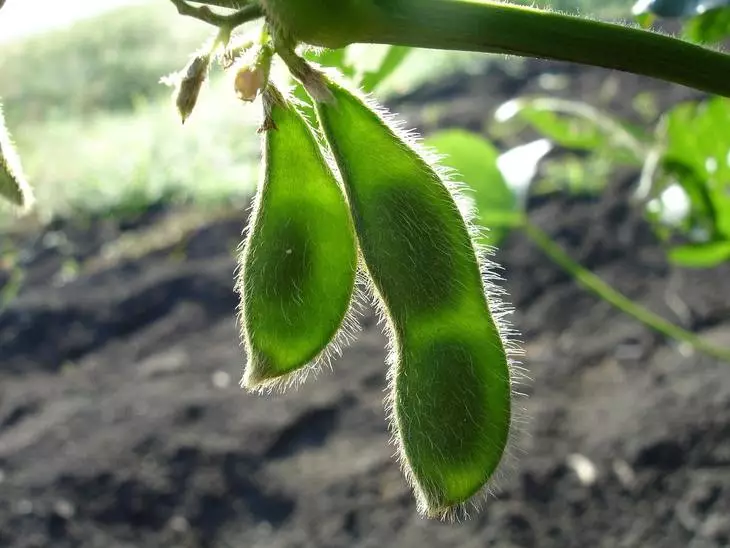
A group of scientists from Nanking Agricultural University, Institute of the Heilongsian Academy of Agricultural Sciences (HAAS) and the Northeast Forest University in Harbin acted as the creation of Chinese reserves. In an article published on the MDPI portal, the authors, in particular, write the following.
"Cultural soybean is an economically important harvest, widely applying as food for both human and livestock. Although the yield of soybeans has increased over the last century (for selection of soybean lines with high yields, various types of technologies have been developed), a narrow genetic base - a problem. Today, soybeans are needed not only high-yielding, but also with resistance to environmental stresses.
Thus, there is an urgent need to study the rich resources of genetic diversity.
Wild soy contains important genes for adapting to various harsh environmental conditions from salinity to the attack of pests insects. These genes of wild soybeans can be re-introduced into domesticated varieties due to the lack of a barrier for breeding between wild and cultivated soy.
It was suggested that wild soybean comes from East Asia, and in China, the culture domesticated 6000-9000 years BC. In particular, Soya is one of the main crops in the province of Heilongjiang, located in the north of China, where you can find resources Dijoros in connection with the unique geographical and environmental environment.
In order to develop the soy industry, a comprehensive assessment of the agronomic characteristics of the Wild Soyo will enrich the genetic basis and take a breakthrough in soybean selection.
In this work, a total of 242 sample of the germinal plasma of the Wild Soybean was investigated. They were selected in 13 cities of Heilongjiang province and geographically distributed in four regions, namely: Northern (Region I), Eastern (Region II), South (Region III) and Western (Region IV) Plots of Hailongjiang Province.
These four regions were divided into categories based on their relief, soil and climate characteristics.
- In the region I - the cool and wet climate, the relief was characterized by wide rounded mountains with wide and small river valleys.
- Region II belonged to agricultural and pasture races at low and flat terrain with fertile soil and large amounts of water resources.
- Region III contained complex form of relief with various types of vegetation, intersection of rural and forestry and abundant water resources.
- In the region IV, a special type of relief and soil conditions that are not contributing to the growth of trees, represented a meadow steppes.
All experiments were conducted in the National Agricultural Demonstration Zone of the Academy of Agricultural Sciences of Heilongjiang Province in the summer of 2012 and 2013. In total, 14 agronomic signs were investigated on soybean samples grown from wild self-sighs.
The growth image of wild soybean was significantly different from cultural, including habits for a colon, a high height of plants and subtle stems that had to be written with bamboo sticks. A wide range of variability was documented in all samples of wild soybean, in particular, the weight and number of seeds on the plant, the pods and the number of nodes.
Only five agronomic signs (for example, the mass of 100 seeds, the mass of seeds on the plant, the number of seeds on the plant, the amount of effective pods and the number of invalid pods) significantly differed between the samples.
Samples on the southern portion showed the largest mass of 100 seeds (3.26 g), the mass of seeds on the plant (30.03 g) and the number of branches (6.00 g). On the contrary, the Northern Plot was characterized by the smallest weighing 100 seeds on a plant (1.62 g), a mass of seeds on a plant (11.07 g), the amount of effective pods (219.75), the amount of invalid pods (18.56), the number of branches ( 4.72).
Samples from Western and Eastern plots showed intermediate values for weight 100 seeds (1.67 and 2.75 g, respectively), seed weights on a plant (16.57 and 27.38 g, respectively) and the number of branches (5.42 and 5 , 97, respectively).
Studies have shown that the high genetic diversity of wild soybeans obtained as a result of a long selection led to the adaptation of wild soybeans in various types of environmental habitats. Most of the "northern" samples contained needle leaf, small seeds, no obvious main stem, low weight 100 seeds and high diversity index.
At the same time, the wild soybean in three other places of collection had elliptical and oval leaves with large seeds, white flowers and the main stem, which could be associated with the rapid development of agriculture and human intervention, accelerating the evolution of these wild soybeans.
The priority area for the protection of wild soybean was chosen the Northern Plot of the province of Heilongjiang, located in the regions of Da Sin An Lain and Xiao Sin An Lin, where the mountains are round and extensive, and the climate is cold, and the natural environment is almost not populated. Compared to other sites, the northern plot is characterized by a shorter growing season for crops due to limited relief, climatic conditions and human factor. It is expected that this northern site may contain the richest resources of the wild soybean, which is recommended to protect in situ.
(Source: www.mdpi.com).
